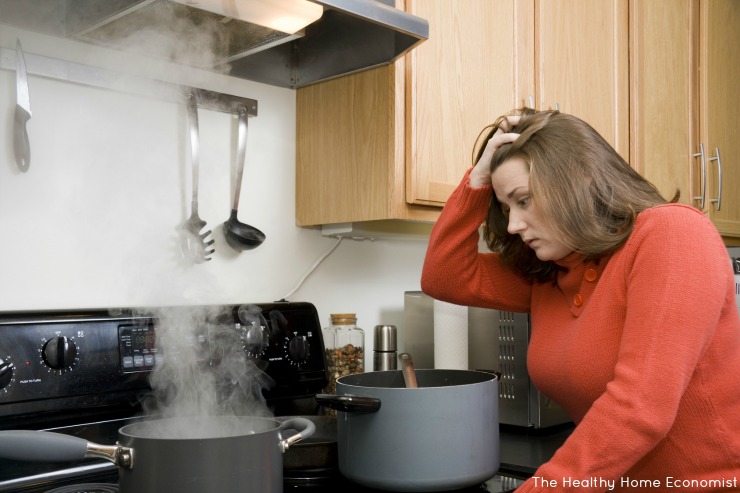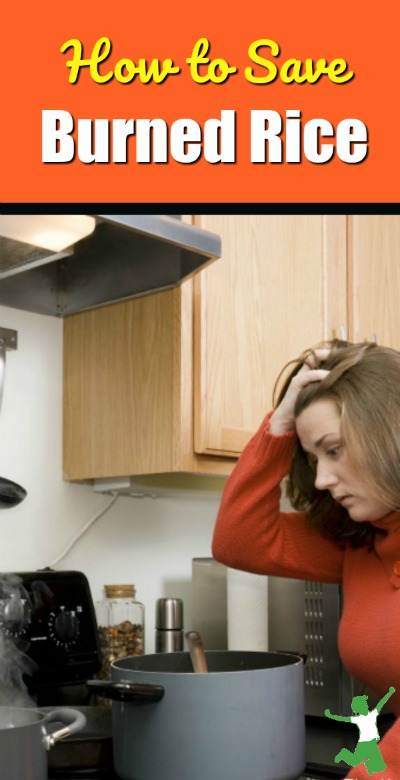Table of Contents[Hide][Show]
A pot of burnt rice is a common kitchen mistake, but there is no need to throw it out when you can easily salvage the process and save dinner!
If you prepare a lot of home-cooked meals, you have probably already figured out that it’s fairly easy to end up with burnt rice. It doesn’t matter if you use white or brown rice. They both seem to burn fast if you get distracted and leave the pot untended. Wild rice poses the same risks for the harried cook.
Kids, laundry, phones ringing, homework, the doorbell ringing, and countless other distractions can keep you from getting the rice pot off the heat at the right time. You can also end up with burnt rice if you turn the heat up too high even if the rice isn’t done yet.
Beyond the sheer embarrassment of such a beginner food flop, burnt rice is a fairly expensive mistake. Unless that is, you happen to be using a cheap box of Rice-A-Roni. We won’t even go there…
I will just assume that you are making rice with the good stuff!
Salvaging a Pot of Burned Rice
If you use mineral and gelatin-rich bone broth instead of plain water like I do and buy quality (arsenic-free) grain and (expensive) pastured butter, a batch of burnt rice can easily cost you $10 or even more if you cook large quantities.
If you doubt that a simple pot of even cooked white rice is worth that much, consider that my local health food store sells refrigerated, 12 oz/ 355 ml jars of real beef broth for $15 each.
Shelf-stable jars of authentic chicken bone broth cost a bit less. To cook a small pot of rice, you need 3 cups of bone broth. This one ingredient alone would cost about $25-30 if you purchased it!
Yes, that gallon of homemade bone broth you make every week is worth quite a bit at retail!
Beyond the money lost, what about the time (8 hours minimum) it took to soak the rice before it was put on to cook? Preparing grains properly takes extra effort (your digestion and waistline will thank you), so when burnt rice is the issue, the modern fix of just throwing instant rice in the microwave is not going to save dinner in a way that would be satisfying for the traditional cook.
In situations like this, it literally pays to know what to do to salvage the process!
Burnt Rice? Don’t Panic
If you notice that you have a pot of burnt rice on your hands, first of all, don’t panic. Take the pot off the stove, turn off the heat, and turn on the fan.
Why the fan you ask? Well, you don’t want to set off the smoke alarm or have someone smell the evidence from the other side of the house and wander over to ask if you burned the rice (again), right?
Quickly take the pot over to the sink and run cold water over the bottom. This will halt the cooking process. Take care to hold the lid on so that nothing spills into the sink.
Next, gently pour the unburned rice and remaining rice water mixture into a clean pan. Take care to leave any burned rice kernels stuck to the bottom of the first pan as is.
Lastly, place a slice of bread on top of the rice mixture. Cover and finish cooking. Hint: crusts don’t work as well as a regular slice of bread in my experience. The bread will absorb any burnt taste that might remain, and the fan will take care of the burned odor in the kitchen.
Serve as usual. Your family will never know!
Whew!
How to Never Have Burnt Rice Again
I must use a large frypan to make traditional Indian saffron rice and my Spanish yellow rice recipe (to gently heat the aromatic spices). If I’m making plain rice, however, I avoid the risk of burning by using a clay pot.
Clay pot cooking is an ancient tradition that dates back millennia. It differs from cooking in other materials such as ceramic or stainless steel because the clay is a porous material. This helps to better retain moisture, flavor, and nutrition. It also cooks at a lower temperature so burning rice or any other food cooked in it is very difficult.
In addition to intensely flavorful food (compared with the bland, somewhat boiled taste of food cooked in a crockpot), the moist clay combined with the double lid design of an electric clay pot creates a micro pressure environment which allows for much-improved cooking efficiency. This means you save electricity and time. In fact, clay pot cooking can have your meal ready in up to half the time compared with using other slow cookers. And, the clay pot will stop cooking the rice at the right time and keep it warm without burning until you are ready to serve.
Now you know not only how to fix burnt rice, but how to avoid it in the first place! Psst. it works for wild rice too!









I make my own stock from bones. After the bones are finished cooking over low heat, I remove the bones from the stock and continue cooking. I simmer the stock until a 15-liter stock is reduced to 1 to 2 liters. After that, I let it cool and then place it in the fridge. Now all I have is collagen. I cut up the collagen into sections and wrap it. Then I place the collagen into the freezer. Now I have instant soup stock when I need it.
So you don’t have a specific brand you recommend? I was reading your article on RealFarmacy.com about wheat being toxic and some rice being sprayed with RoundUp before harvest. How would you know?? Please give me an amazon link to the rice you use/recommend. Thank you for your time!!
Since we have gone gluten free due to my daughter’s AI we don’t have any bread in the house. Guess my burnt rice is still going in the trash. 🙂
Or Um…. use the absorption method of cooking rice and then you can ignore the pot and it wont burn.
Bring rice and water to the boil (we add some coconut oil) then once boiled reduce to the lowest heat possible on your stove and put pot lid on. Once all water (broth/stock/whatever) is absorbed it is ready. Doesn’t take long and good consistency every time.
Depending on the type of pot you are using, running cold water over a hot pot could cause it to warp and not sit flat the next time you want to use it. An electric pressure cooker takes the guess work out of cooking rice- it turns out perfectly every time.
Sarah, this post was a reminder of how much I still love my electric clay pot. I’ve had it for about 9 months now and love it even more than when I first got it–I use it most every day. Thanks again for the recommendation for what has become my favorite appliance, which says a lot, because I am an appliance junkie!
I use mine all the time too! So glad you are loving it 🙂 I’ve had mine almost a year now and don’t know what I ever did before I had one!
Where do you buy arsenic free rice?
Some companies test the soil to ensure there is no arsenic before growing rice. When you flood the fields to grow the rice, the risk of arsenic coming out of the soil into the rice is greater. So buying rice that is grown without flooding is one way as well. Talk to the company that markets the rice or the farmer directly to inquire. Some companies are now testing to ensure an arsenic free product.
I would love to have a vita clay cooker! Even though I cannot eat rice there are so many things I could cook in it. But their largest size would not make enough food to feed half my family! Why are they so very small???!!
The large Vita-Clay holds a gallon and easily feeds my family of 5 with leftovers. You can put quite a bit in there.